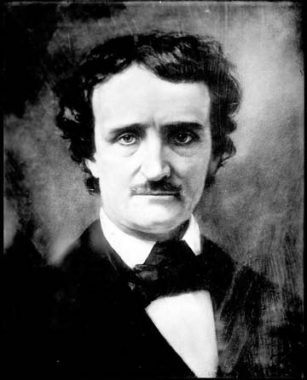
The following is a transfer of a page written in 2010; the original photo galleries weren’t functioning. Therefore, some info may be outdated. Some of the photos were imported at a smaller size than I do at present.
Since the mysterious Poe Toaster has now apparently moved on to join the Choir Invisible, I thought it appropriate to pay homage of my own to Edgar Allan Poe in Forgotten NY. If you’re not familiar with the story, a mysterious figure, or figures (the tradition started in 1949) bearing a silver tipped cane, proceeded to Poe’s gravesite in early morning at Westminster Hall and Burying Ground, hoisted a Cognac toast, and left three red roses and the Cognac. It is thought that the toaster had been one person and his son. Jeff Jerome, curator of the cemetery, had no contact with the Toaster.
The Crotona Park and Hunts Point neighborhoods in the Bronx boast a number of streets named for the literary lights of the USA in the early to mid 1800s, such as [William Cullen] Bryant, [Henry Wadsworth] Longfellow, [John Greenleaf] Whittier, [Joseph Rodman] Drake, and Fitz-Greene Halleck. Another, Edgar Allan Poe, is also remembered, not by an avenue, but by a dead-end alley issuing from another little-remembered lane in Fordham, not far from the small cottage where he lived beginning in 1846 with his cousin-wife, Virginia, and her mother, Maria, until 1849; Virginia died of tuberculosis in 1847. I cannot but feel that Poe would have chuckled at the inconsequential lane that bears his name in the Bronx, while his contemporaries received much longer thoroughfares; Poe once accused Longfellow of plagiarism. A longer Poe Avenue was mapped in Hunts Point in the 1800s, but has either disappeared or was never built.
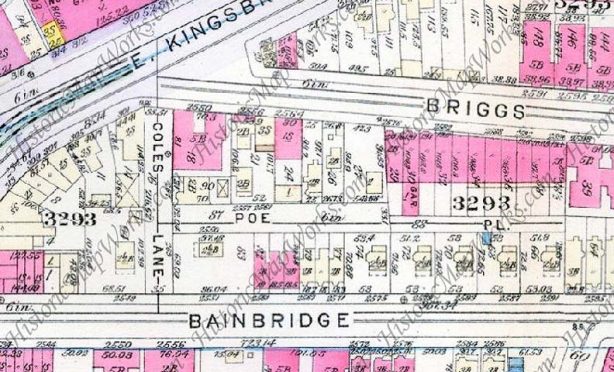
From an atlas made during the 1910s, note Coles Lane running between Briggs Avenue at East Kingsbridge Road and Bainbridge Avenue, and the dead end Poe Place running north from it. I’m not sure when each lane first appeared, but I’d guess it would be the late 1800s.
Coles Lane
This short street, which is in the line of East 192nd Street but somehow avoided getting numbered, was named for the Postmaster of Fordham in the 1860s, Jacob Cole; he and his brother Andrew were residents here in the 1870s, and I’d have to guess this was the road that led to their homes, perhaps a carriage path.
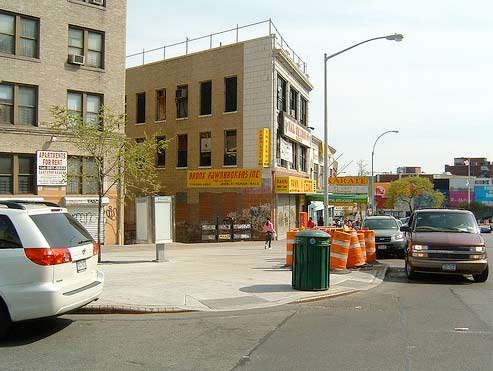
Coles Lane, at the junction of Briggs Avenue (foreground) and East Kingsbridge Road (right). The narrow lane has been closed to traffic from the Kingsbridge Road side for quite a few years.
Bronx Pawnbrokers, minus the traditional 3-ball symbol, is at the corner of Coles and Kingsbridge.
I really should do a Kingsbridge Road page soon — it’s among the Bronx’ oldest roads, built along the path of a pre-colonial trail. Though it officially ends at Fordham Road, its trail east of that can be traced in the paths of Third Avenue, East 182nd Street and Grote Street.
Coles Lane is on a steep hill between Kingsbridge and Bainbridge. A pedestrian walkway allows entry from KIngsbridge to the actual lane, which is a few feet below. We see the remnants of an ancient railing pedestrians can grab onto during slippery weather. A pedestrian staircase allows entry to East Kingsbridge Road.
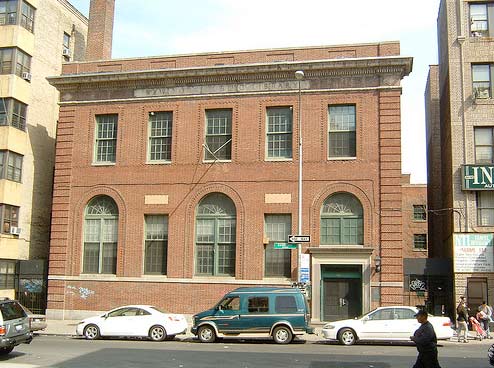
Fordham Public Library building, 2556 Bainbridge, facing Coles Lane, was slated to be transformed into an animal shelter in 2008 despite community opposition; it has stood empty after it closed in 2005.
Poe Place
As we’ve said, Poe Place honors Edgar Allan Poe, the literary master and poet, born in Boston in 1809 and died in Baltimore in 1849. He lived in many places along the East Coast, with two stints in what became Greater NYC (when he lived in the Bronx in 1846-1849, it was part of Westchester County) as well as in Philadelphia, Providence, Richmond, VA among others. He dealt in horror, wrote some of the first detective fiction, and even some early forays into science fiction. A dead-end alley named for Poe is oddly fitting, as he battled many personal demons including alcoholism …
I looked upon the scene before me – upon the mere house, and the simple landscape features of the domain – upon the bleak walls – upon the vacant eye-like windows – upon a few rank sedges – and upon a few white trunks of decayed trees – with an utter depression of soul which I can compare to no earthly sensation more properly than to the after-dream of the reveller upon opium – the bitter lapse into everyday life – the hideous dropping off of the veil. There was an iciness, a sinking, a sickening of the heart – an unredeemed dreariness of thought which no goading of the imagination could torture into aught of the sublime. What was it – I paused to think – what was it that so unnerved me in the contemplation of the House of Usher?
The last thing you’d expect to find on Poe Place is a boat, but here one is, far from the shore. What eldritch turn of events caused this barque to beach at this remote point?
My name is Arthur Gordon Pym. My father was a respectable trader in sea-stores at Nantucket, where I was born. My maternal grandfather was an attorney in good practice. He was fortunate in every thing, and had speculated very successfully in stocks of the Edgarton New Bank, as it was formerly called. By these and other means he had managed to lay by a tolerable sum of money. He was more attached to myself, I believe, than to any other person in the world, and I expected to inherit the most of his property at his death. He sent me, at six years of age, to the school of old Mr. Ricketts, a gentleman with only one arm and of eccentric manners- he is well known to almost every person who has visited New Bedford. I stayed at his school until I was sixteen, when I left him for Mr. E. Ronald’s academy on the hill. Here I became intimate with the son of Mr. Barnard, a sea-captain, who generally sailed in the employ of Lloyd and Vredenburgh- Mr. Barnard is also very well known in New Bedford, and has many relations, I am certain, in Edgarton. His son was named Augustus, and he was nearly two years older than myself. He had been on a whaling voyage with his father in the John Donaldson, and was always talking to me of his adventures in the South Pacific Ocean. I used frequently to go home with him, and remain all day, and sometimes all night. We occupied the same bed, and he would be sure to keep me awake until almost light, telling me stories of the natives of the Island of Tinian, and other places he had visited in his travels. At last I could not help being interested in what he said, and by degrees I felt the greatest desire to go to sea. I owned a sailboat called the Ariel, and worth about seventy-five dollars. She had a half-deck or cuddy, and was rigged sloop-fashion- I forget her tonnage, but she would hold ten persons without much crowding. In this boat we were in the habit of going on some of the maddest freaks in the world; and, when I now think of them, it appears to me a thousand wonders that I am alive to-day.
The waters of the river have a saffron and sickly hue; and they flow not onwards to the sea, but palpitate forever and forever beneath the red eye of the sun with a tumultuous and convulsive motion. For many miles on either side of the river’s oozy bed is a pale desert of gigantic water-lilies. They sigh one unto the other in that solitude, and stretch towards the heaven their long and ghastly necks, and nod to and fro their everlasting heads. And there is an indistinct murmur which cometh out from among them like the rushing of subterrene water. And they sigh one unto the other. The Narrative of Arthur Gordon Pym of Nantucket (1838)
The doorway on Poe Place, with its ceramic ornamentation, seems to be the back end of the Bainbridge Avenue Group Home …
Back into the chamber turning, all my sour within me burning,
Soon again I heard a tapping something louder than before.
“Surely,” said I, “surely that is something at my window lattice;
Let me see, then, what thereat is and this mystery explore–
Let my heart be still a moment and this mystery explore;–
‘Tis the wind and nothing more.Open here I flung the shutter, when, with many a flirt and flutter,
In there stepped a stately Raven of the saintly days of yore.
Not the least obeisance made he; not a minute stopped or stayed he,
But, with mien of lord or lady, perched above my chamber door–
Perched upon a bust of Pallas just above my chamber door–
Perched, and sat, and nothing more.Then the ebony bird beguiling my sad fancy into smiling,
By the grave and stern decorum of the countenance it wore,
“Though thy crest be shorn and shaven, thou,” I said, “art sure no craven,
Ghastly grim and ancient Raven wandering from the Nightly shore–
Tell me what thy lordly name is on the Night’s Plutonian shore!”
Quoth the Raven, “Nevermore.”
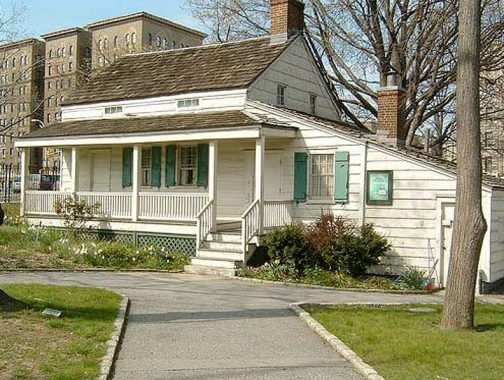
Poe Cottage
Fortunately, the City offers a more respectable tribute to the horror master. The cottage where he lived from 1846-1847 with his cousin/wife Virginia and his mother-in-law has been preserved in Poe Park, at the Grand Concourse and East Kingsbridge Road, just a couple of blocks away.
When Poe lived in this small farmhouse there was no Grand Concourse, and the house stood far out in the country. That’s what Poe was looking for, believing the clear country air would invigorate his ailing young wife, who had tuberculosis. Tragically, it did not work and Virginia died; one of his best-known poems, “Annabel Lee”, is thought to memorialize her.
Annabel Lee
It was many and many a year ago,
In a kingdom by the sea,
That a maiden there lived whom you may know
By the name of Annabel Lee;
And this maiden she lived with no other thought
Than to love and be loved by me.
I was a child and she was a child,
In this kingdom by the sea:
But we loved with a love that was more than love –
I and my Annabel Lee;
With a love that the winged seraphs of heaven
Coveted her and me.
And this was the reason that, long ago,
In this kingdom by the sea,
A wind blew out of a cloud, chilling
My beautiful Annabel Lee;
So that her high-born kinsmen came
And bore her away from me,
To shut her up in a sepulchre
In this kingdom by the sea.
The angels, not half so happy in heaven,
Went envying her and me –
Yes! that was the reason (as all men know,
In this kingdom by the sea)
That the wind came out of the cloud one night,
Chilling and killing my Annabel Lee.
But our love it was stronger by far than the love
Of those who were older than we –
Of many far wiser than we –
And neither the angels in heaven above,
Nor the demons down under the sea,
Can ever dissever my soul from the soul
Of the beautiful Annabel Lee;
For the moon never beams without bringing me dreams
Of the beautiful Annabel Lee;
And the stars never rise but I feel the bright eyes
Of the beautiful Annabel Lee;
And so, all the night-tide, I lie down by the side
Of my darling -my darling -my life and my bride,
In the sepulchre there by the sea –
In her tomb by the sounding sea
Poe and his family were destitute while living in the little farmhouse. He was a literary success but had lost his savings in a failed magazine venture. The author and his mother-in-law had to forage in nearby fields for the family’s sustenance. The cottage itself was built in 1812 by farmer John Wheeler and stood on Kingsbridge Road until it was moved to its present location in 1913.
The house is one of four Poe museums in the USA; it is sparsely furnished in the fashion Poe must have had while here. It is thought that the bed, gold-framed mirror and rocking chair belonged to Poe himself. Tours of Poe Cottage can be arranged with the Bronx Historical Society at (718) 881-8900. The cottage has been recently renovated and a new visitor center has been constructed.
Poe Cottage and the forlorn alleyway are not the only tribues to EAP in Kingsbridge. Several businesses along the Grand Concourse at Kingsbridge Road were named for him — at least in 2014 when I grabbed these shots.
Check out the ForgottenBook, take a look at the gift shop, and as always, “comment…as you see fit.”
Originally 6/10; revised 6/4/20


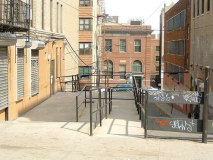
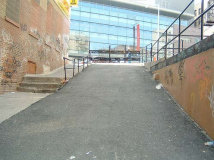
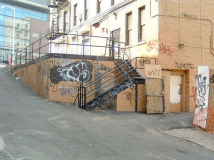
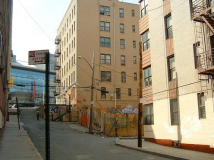
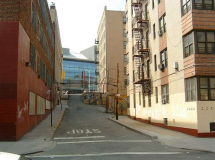
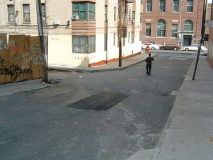
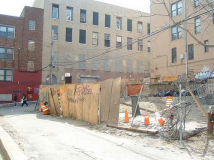
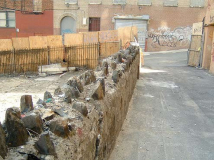
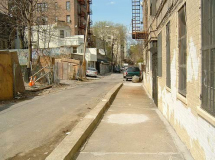
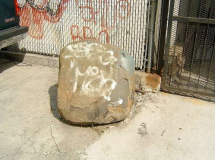
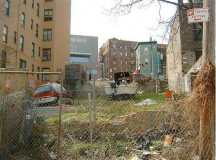
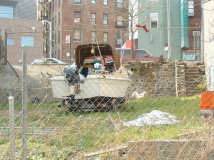
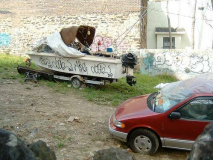
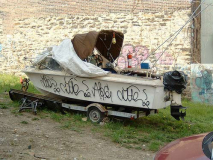
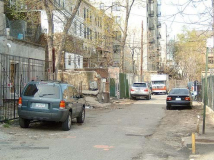
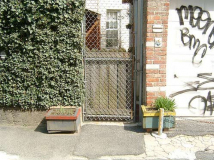
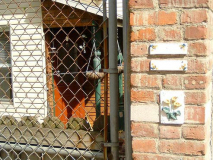
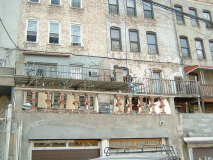
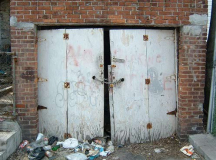
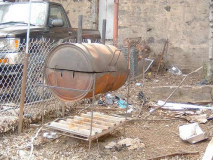
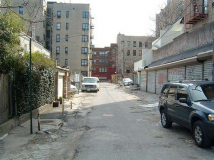
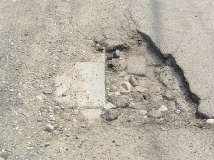
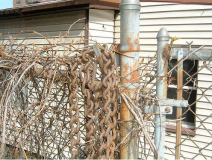
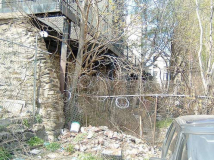
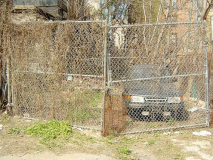

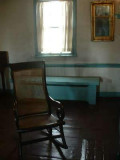
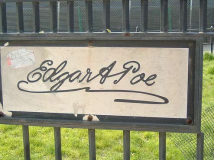
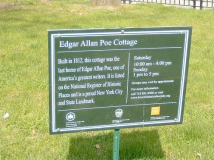
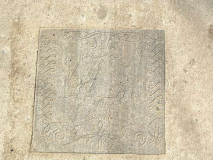
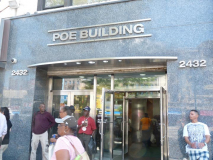


5 comments
My aunt and uncle lived a few blocks away on Pond Place..we visited Poe Park often, as well as the wonderful Bronx
Zoo
I grew up not far from Coles Lane on the other side of the Grand Concourse. Would walk down Coles Lane from Kingsbridge Road to Bainbridge Ave to get to the library. On the other side of Kingsbridge Road was Jahn’s ice cream parlor and offices for both NY Telephone and Con Edison. You can pay your phone bill and play with the “new” touch tone phones (they even had a video phone there). I seem to recall that the Con Edison storefront was where you could pay your bill and buy gas appliances. And Jahn’s was the home of great food and desserts. Coles Lane was not paved and there was a drop of a few feet from the sidewalk on Kingsbridge Road to the dirt area — the two walkways on either side were there back then — one was mostly stairs, the other I think just a continuous ramp.
I worked at that library for a short time while in high school. It was the main Bronx reference library. I think it was moved up to Kingsbridge Road into the spaces formerly occupied by NY Telephone and Con Ed.
Reminds me of Hamilton’s house. which was also moved (maybe twice?) around Manhattan.
His Hamilton Place road looks a lot better than Poe Place, however.
Remember I used to be live-in docent of Poe Cottage, I lived in the basement of Poe Cottage! An unforgettable time in my life!!!
I grew up on E199th St between Briggs Ave and Bainbridge Ave. My elementary school was PS 46 on E196th St and was named for Poe. https://www.ps46bronx.org/